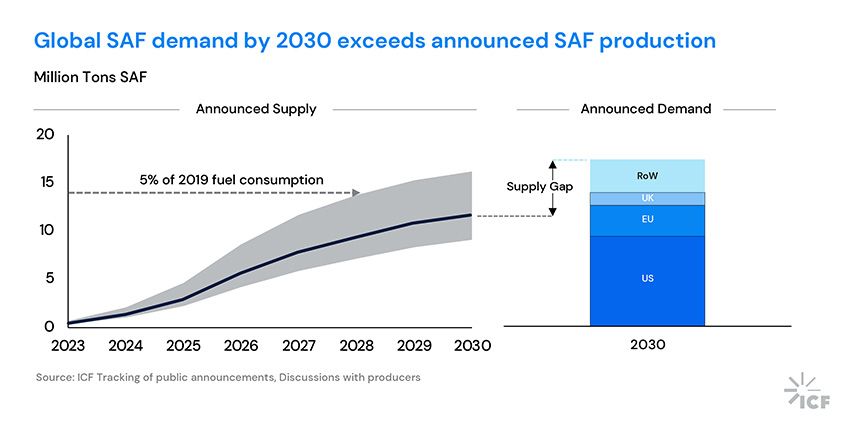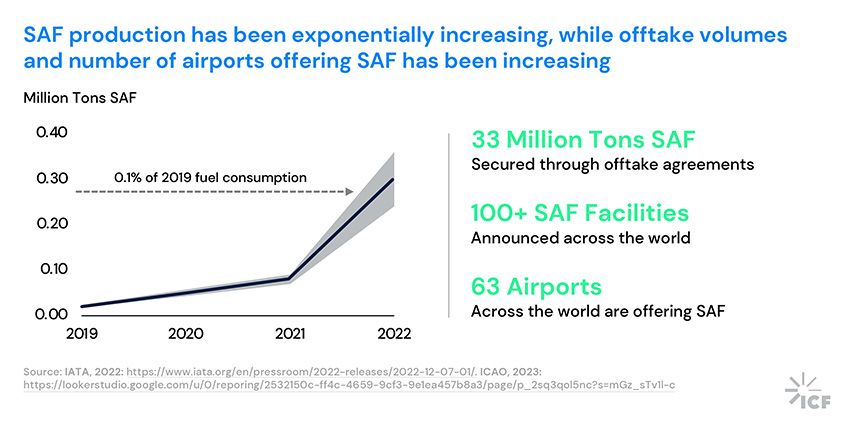
Scaling SAF: Aviation's license to growth
The aviation industry has set out goals to maintain its social license to operate, by tackling its increasing emissions. The only realistic way to achieve this is by rapidly deploying a basket of measures. These include operational improvements, market-based measures (CORSIA), advanced aircraft technology (e.g., hydrogen aircraft), and the utilization of Sustainable Aviation Fuels (SAF).
SAF production is recognized as the most significant lever. Public and private aviation industry stakeholders are working across the world to scale up SAF. However, compared to industry aspirations, a supply gap still remains.
What is the current outlook for the SAF industry?
According to IATA, 240,000 to 360,000 tons of SAF was produced and fully utilized in 2022. This is less than 0.2% of the global fossil-based Conventional Aviation Fuel (CAF) consumption, but still three times of 2021’s SAF production.

If we only built the facilities announced so far, SAF would make up around 12 million tons—about 4% of estimated global commercial aviation fuel usage by 2030. Many more will be announced, but equally many will run into difficulties—entering operation later than expected, or not even being built if they struggle to raise capital, obtain permits or hit technical difficulties. Even if they are, they will still adapt production to maximize profit, and it is essential to ensure that producing SAF is profitable, to make it financially sustainable. In many cases today, it is more profitable to produce renewable diesel, due to established market and policy measures. There must be a level playing field for the different fuels.

Announced SAF facilities are currently concentrated in the US, EU, and the UK. One of the key reasons for this is the SAF-specific policy instruments in these counties. Just like any other early-stage technology, SAF requires policy support to scale up. These policy measures can be in the form of carrots or sticks, such as incentives for SAF production in the US, or mandates for SAF utilization/blending in the EU and the UK. We know that we need to dramatically scale SAF production and use to achieve our climate goals, and to achieve our growth ambitions as an industry. But how can the industry do this?
How can we scale SAF production?
Scaling up SAF will require collaboration across the whole aviation value chain, including airlines, fuel producers and suppliers, policymakers, financial institutions and investors, airports, and research institutions. There are already great examples of this collaborative effort, from the UK’s Jet Zero Council to the UAE’s SAF Committee (highlighted in a recent report, to which ICF also contributed).
The recent ban on domestic flights in France is a stark illustration of the choice we face, between increasing the amount of SAF, or reducing the amount of growth we’re expecting. As part of their attempts to cut carbon emissions by 40% by 2030, France banned some domestic flights in April 2022. The ban covers routes that could be travelled by train or bus in under two and a half hours.
ICF research shows that there are four key areas to consider, as we look at scaling the SAF industry through collaborative efforts: Policy, Economics, Technology, and Sustainability.
These areas all interact, so a holistic approach covering all stakeholders and key areas is essential. Stakeholders will also need to collaborate across this value chain. Here, we look at each one in turn.
Economics
We must ensure that it is economically sustainable to produce SAF, which requires policies to close the cost differential with CAF. As just one example, a ton of used cooking oil, will currently cost more than a ton of jet fuel. This creates a ‘Green Premium,’ where customers have to pay a premium for SAF over CAF. However there are proven examples of substantial cost reduction, as seen in deployment of solar energy technologies. Solar PV costs (USD/kWh) decreased by around eight times between 2011 and 2021, while installed capacity increased by twelve times. Between 2019 and 2022, SAF production increased by over ten times, and this trend is expected to reduce production costs.
Technology
According to the Waypoint 2050 Report—which ICF contributed to—it is needed to considerably scale the amount of SAF used by the aviation industry to achieve its targets. To go through the energy transition as an industry, SAF needs to be scaled from a very small amount—much less than one per cent of the aviation fuel usage today—to around 400 million tons of SAF by 2050. While this is considerable, it is feasible if we support the development and deployment of SAF technology.
There is currently a lot of attention on newer technologies like Power to Liquids (PtL), which removes the feedstock-related barriers by only using water, renewable energy and CO2 as inputs. But by 2030, we will still see more Hydroprocessed Esters and Fatty Acids (HEFA) production, as it is the most mature SAF production technology today. Across North America there is a significant amount of announced HEFA production, with a proportion of Alcohol to Jet. This mostly comes from corn starch, driven by the sustainability considerations of U.S. policies— and is one of the reasons why the U.S. has such a large SAF production coming online.
The EU is also dominated by HEFA in the short term, due to the pressure of investing under an uncertain mandate. Many are working to define what the EU refuel mandate will look like, but there are still a lot of unanswered questions. Proposed ReFuelEU legislation also includes a sub-mandate for PtL SAF, which increases substantially by 2050. The EU Commission and EU Parliament are still discussing their final SAF targets.
In the UK, the picture is dominated by the more advanced pathways such as Municipal Solid Waste to Fuel. That has implications in terms of capital investment, and contributes to the UK having a relatively small amount of fuel. Getting to the UK’s 10% goal by 2030 will require additional facilities.
The role of scaling up SAF technology in closing the Green Premium, which refers to the additional cost between CAF and SAF after taking any potential incentives into consideration, is twofold.
First, better technology brings down production costs. Secondly, it allows access to more feedstocks and facilities in different locations. As an industry, we can draw on considerable experience in other renewables, for example solar, where we have seen decreasing costs as these industries deploy. A decade ago, solar was five times the price of conventional fuel. Today, solar is the cheapest form of electricity in most parts of the world—an incredible transformation. SAF is where solar was ten years ago, at a high price, because the technology is still at an early stage in comparison to the mature fossil fuel industry. This will change as we develop the SAF industry and gain additional feedstocks and pathways.
Sustainability
Customers will be willing to pay the Green Premium if they see that sustainable fuels have a high value, both in the low cost of the fuel itself and the emissions reductions. We must maximize that sustainability value. With each technology and feedstock type, we must examine the value chain—if we can make SAF more sustainable too, in addition to reducing its cost, this is another way to maximize its value. For example, wood from a forest would be unsustainable compared to sawdust.
Airlines or producers must challenge and understand what feedstock is being used, and how sustainable it is too. Certification is an important part of making sure this happens.
There are also other ways to ensure that feedstocks are sustainable—for example, through regenerative agriculture. Beyond that, every SAF facility will also need a range of inputs such as renewable electricity, natural gas, or hydrogen. Operationally, sustainability is also about looking at logistics and making sure we’re moving feedstocks and fuels as short a distance as possible—and then any carbon that is released can be collected using carbon capture.
Policy
SAF technology is at an early stage of development. For it to successfully scale, it must have a range of policy support, from incentives to mandates. The policies that are currently in place, or planned, fall into two broad categories.
-
International / supranational strategies and targets
Targets set by IATA create a direction of movement and reinforce the shift to the SAF market. In October 2022, the 41st ICAO Assembly also adopted a long-term global aspirational goal (LTAG) for international aviation by 2050. - National policies
- U.S. – The U.S. has an incentive-based market. A notable example is the U.S. Sustainable Skies Act. This legislation proposes a tax credit for SAF, with the aim of incentivizing and accelerating SAF production on a commercial scale.
- EU/UK – This region is focused more on mandates. Examples include ReFuelEU Aviation, which aims to boost production and uptake of SAF by mandating aviation fuel suppliers to ensure that all aviation fuel supplied to EU airports has a proportion of SAF.
- Global – The global policy landscape is still emerging, with a range of mandates and targets. Dominated by HEFA capacity, these countries are often seeking to sell SAF into countries with existing policy regimes, across North America, the EU, and the UK.
The right policies can have huge value. There are many different mandates and policy structures that we can use, but in essence, policy is about closing the Green Premium and making sure that a fair cost is distributed between everyone who has a stake in the industry. Because policy plays such an important role, it is also intrinsic to scaling the industry. With SAF consumption concentrated in only a few countries, it is striking that around 43% of Available Seat Kilometers (ASKs) are operated from countries with significant production centers in the US and EU, where there are many policies to support them.
Another 39% operate international flights with fuel from countries without significant SAF policies, but they are covered by CORSIA. The remaining 18% is for domestic flights in countries without large-scale policy support and are not covered by CORSIA, meaning that currently there is a significant cost premium for SAF buyers in those countries.
This underlines the need to recognize that we are a global industry and that we need to deepen and broaden policies to more countries and develop the policy environment to ensure that SAF is economically viable.
There is a sustainability consideration too: policy must also support the right kind of fuel deployment. Policy can bind sustainability and economic considerations together. Landing it successfully will require a different approach in each country, to ensure that their domestic industry is scaling effectively. Policymakers must create policies that deliver true value to the industry, in a potentially volatile sector. Mandates create demand, and airlines are also setting their own targets, which in turn drives demand. This increasing demand is a strong signal for investors and producers to scale up and invest in SAF. Ultimately, the policies that we choose will influence the SAF capacity that we get.
A new license for growth
The aviation industry is committed to reducing its emissions and sustaining its growth, and SAF is widely recognized as a key tool to deliver this target. Production levels are currently low, and the prices are high for commercial viability—but this will change as production scales up with the collaborative efforts of the industry stakeholders, and the policy support.